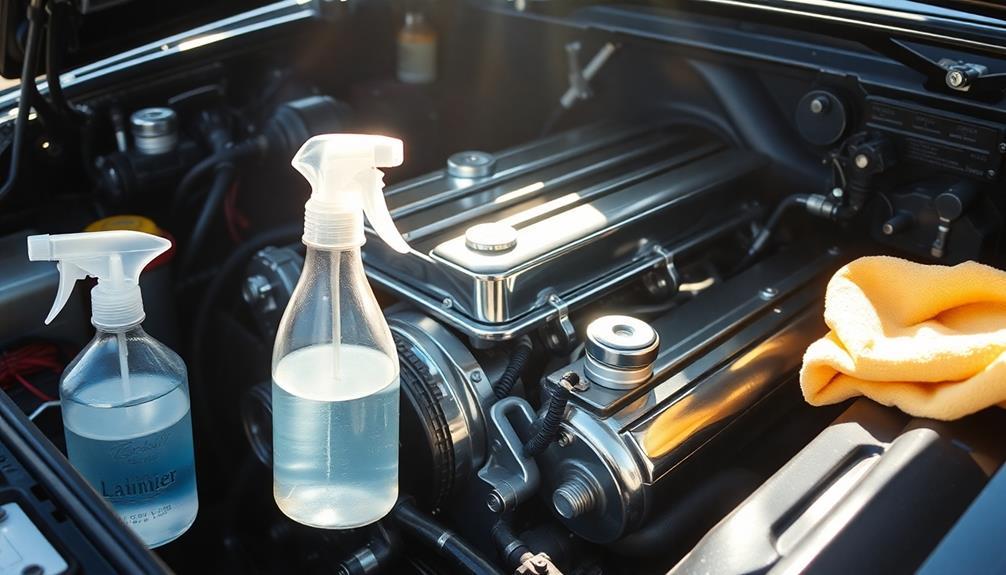To replace your spark plugs, start by ensuring the engine is cool and disconnect the negative battery terminal. Locate the spark plugs and remove the ignition wires or coils carefully. Use a spark plug socket and ratchet to unscrew the old plugs, inspecting them for wear. Before installing new plugs, set the correct gap and screw them in by hand to avoid cross-threading, then tighten to the proper torque. Once reconnected, start your vehicle and check for smooth operation; learning more can help keep your engine running at its best.
Key Takeaways
- Check owner’s manual for correct spark plug type and gap size before replacement.
- Disconnect the negative battery terminal and ensure the engine is cool for safety.
- Remove old spark plugs carefully using a spark plug socket and inspect their condition.
- Install new plugs by hand, tighten to the recommended torque, and reconnect ignition wires or coils securely.
- Start the engine to verify smooth operation and address any misfires or rough idling promptly.

Replacing your spark plugs is a straightforward maintenance task that can improve your vehicle’s performance and fuel efficiency. When you change the spark plugs, you’re directly supporting your ignition system, which is responsible for igniting the air-fuel mixture in your engine. A well-maintained ignition system guarantees that your engine runs smoothly, starts quickly, and maintains peak power. Over time, spark plugs wear out due to exposure to heat, combustion byproducts, and electrical stresses. Worn or fouled spark plugs can cause misfires, rough idling, and reduced fuel economy. By replacing them at regular intervals, you help preserve your engine’s performance and avoid more costly repairs down the line.
To get started, you need to identify the correct spark plugs for your vehicle. Check your owner’s manual or consult with an auto parts store to find the right type and gap size. Once you have the new spark plugs, make sure your engine is cool to avoid injury. Disconnect the negative terminal of your battery to prevent any accidental electrical shocks. Locate the spark plug wires or ignition coils, which are usually arranged along the top of the engine. Carefully remove the wires or coils, noting their order for reinstallation. Use a spark plug socket and ratchet to unscrew the old plugs, turning counterclockwise. Be gentle but firm, as stripped or damaged threads can cause issues during reinstallation.
When installing the new spark plugs, check the gap to verify it’s set correctly according to your vehicle’s specifications. Gapping the plugs is essential because incorrect gaps can lead to poor ignition timing, reduced engine performance, and lower fuel efficiency. Carefully thread the new plugs into the engine by hand to avoid cross-threading, then tighten them snugly with a torque wrench if specified. Reattach the ignition wires or coils, making sure they click into place securely. Once everything is reconnected, start your engine and listen for smooth operation. If you notice misfires, rough idling, or a hesitation during acceleration, double-check the spark plug connections. Additionally, understanding the importance of spark plug technology can help you select the best replacement for your vehicle’s needs.
Regularly replacing your spark plugs not only boosts your engine’s performance but also extends the lifespan of other ignition components. Keeping your ignition system clean and functioning properly helps your engine run more efficiently and reliably. By following these simple steps, you guarantee your vehicle maintains peak power and fuel economy, saving you money and preventing unexpected breakdowns. Remember, a little preventative maintenance goes a long way in keeping your engine running at its best.
Frequently Asked Questions
How Do I Know if My Spark Plugs Need Replacement?
You’ll know it’s time to replace your spark plugs when you notice symptoms of wear like engine misfires, rough idling, or decreased fuel efficiency. Spark plug lifespan varies but generally falls between 30,000 and 100,000 miles, depending on your vehicle and plugs. Regularly inspect them for signs of corrosion, worn electrodes, or deposits, and replace if you see any of these indicators to guarantee peak engine performance.
Can I Replace Spark Plugs Myself Without Professional Tools?
Sure, you can replace spark plugs yourself, but don’t forget DIY safety! You’ll need basic tools like a socket wrench and spark plug socket—no fancy equipment required. Just be cautious: working on your car involves hot engine parts and electrical components, so follow safety tips carefully. With patience and the right tools, you’re all set, but if in doubt, a professional’s always a safer bet.
How Often Should Spark Plugs Be Checked for Wear?
You should check your spark plugs every 30,000 miles or as recommended in your vehicle’s maintenance schedule. Regular inspection helps you monitor their wear and spark plug lifespan, ensuring peak engine performance. Look for signs like corrosion, carbon buildup, or worn electrodes. Staying on top of these checks allows you to catch issues early, extend your spark plug’s lifespan, and avoid unexpected breakdowns.
What Are the Signs of a Faulty Spark Plug?
You’ll notice faulty spark plugs through misfire symptoms like engine hesitation, rough idling, or decreased acceleration. If your platinum spark plug is worn, it may cause poor fuel economy or difficulty starting your vehicle. Keep an eye out for signs like engine knocking or increased emissions. Addressing these issues promptly helps prevent further damage and guarantees your engine runs smoothly. Regular checks will keep your spark plugs in top condition.
Do Different Engine Types Require Different Spark Plug Replacements?
Different engine types do require specific spark plug replacements, so you need to pay attention to engine compatibility and spark plug specifications. You can’t use the same spark plug for a gasoline engine and a diesel engine, for example. Always check your vehicle’s owner’s manual or consult a mechanic to confirm you select the right spark plugs for your engine type, which helps maintain peak performance and efficiency.
Conclusion
Replacing your spark plugs is a simple yet essential task to keep your engine running smoothly. Regular maintenance can improve fuel efficiency by up to 30%, saving you money in the long run. Remember to check your plugs every 30,000 miles and replace them when needed. Staying on top of this small maintenance step guarantees better performance and longevity for your vehicle, making every drive more reliable and cost-effective.









